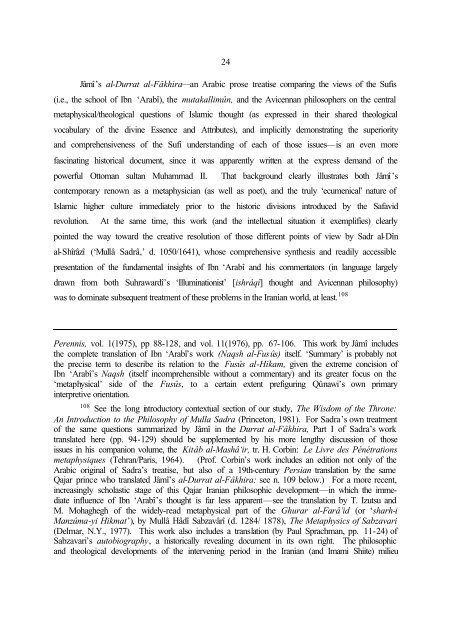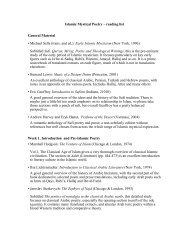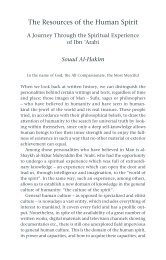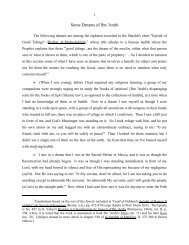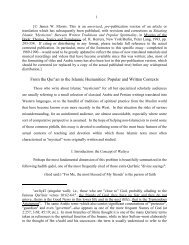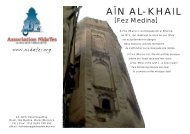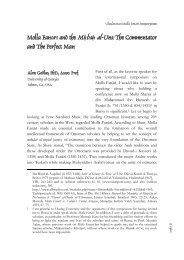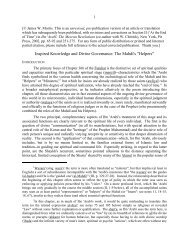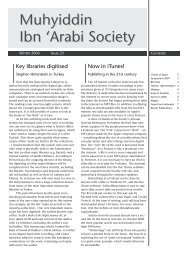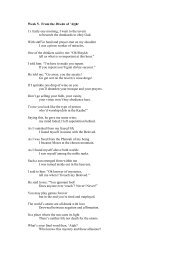Part III (pdf) - Muhyiddin Ibn Arabi Society
Part III (pdf) - Muhyiddin Ibn Arabi Society
Part III (pdf) - Muhyiddin Ibn Arabi Society
Create successful ePaper yourself
Turn your PDF publications into a flip-book with our unique Google optimized e-Paper software.
24Jâmî’s al-Durrat al-Fâkhira—an <strong>Arabi</strong>c prose treatise comparing the views of the Sufis(i.e., the school of <strong>Ibn</strong> ‘Arabî), the mutakallimûn, and the Avicennan philosophers on the centralmetaphysical/theological questions of Islamic thought (as expressed in their shared theologicalvocabulary of the divine Essence and Attributes), and implicitly demonstrating the superiorityand comprehensiveness of the Sufi understanding of each of those issues—is an even morefascinating historical document, since it was apparently written at the express demand of thepowerful Ottoman sultan Muhammad II. That background clearly illustrates both Jâmî ’scontemporary renown as a metaphysician (as well as poet), and the truly ‘ecumenical’ nature ofIslamic higher culture immediately prior to the historic divisions introduced by the Safavidrevolution. At the same time, this work (and the intellectual situation it exemplifies) clearlypointed the way toward the creative resolution of those different points of view by Sadr al-Dînal-Shîrâzî (‘Mullâ Sadrâ,’ d. 1050/1641), whose comprehensive synthesis and readily accessiblepresentation of the fundamental insights of <strong>Ibn</strong> ‘Arabî and his commentators (in language largelydrawn from both Suhrawardî’s ‘Illuminationist’ [ishrâqî] thought and Avicennan philosophy)was to dominate subsequent treatment of these problems in the Iranian world, at least. 108Perennis, vol. 1(1975), pp 88-128, and vol. 11(1976), pp. 67-106. This work by Jâmî includesthe complete translation of <strong>Ibn</strong> ‘Arabî’s work (Naqsh al-Fusûs) itself. ‘Summary’ is probably notthe precise term to describe its relation to the Fusûs al-Hikam, given the extreme concision of<strong>Ibn</strong> ‘Arabî’s Naqsh (itself incomprehensible without a commentary) and its greater focus on the‘metaphysical’ side of the Fusûs, to a certain extent prefiguring Qûnawi’s own primaryinterpretive orientation.108See the long introductory contextual section of our study, The Wisdom of the Throne:An Introduction to the Philosophy of Mulla Sadra (Princeton, 1981). For Sadra’s own treatmentof the same questions summarized by Jâmî in the Durrat al-Fâkhira, <strong>Part</strong> I of Sadra’s worktranslated here (pp. 94-129) should be supplemented by his more lengthy discussion of thoseissues in his companion volume, the Kitâb al-Mashâ‘ir, tr. H. Corbin: Le Livre des Pénétrationsmetaphysiques (Tehran/Paris, 1964). (Prof. Corbin’s work includes an edition not only of the<strong>Arabi</strong>c original of Sadra’s treatise, but also of a 19th-century Persian translation by the sameQajar prince who translated Jâmî’s al-Durrat al-Fâkhira: see n. 109 below.) For a more recent,increasingly scholastic stage of this Qajar Iranian philosophic development—in which the immediateinfluence of <strong>Ibn</strong> ‘Arabî’s thought is far less apparent—see the translation by T. Izutsu andM. Mohaghegh of the widely-read metaphysical part of the Ghurar al-Farâ’id (or ‘sharh-iManzûma-yi Hikmat’), by Mullâ Hâdî Sabzavârî (d. 1284/ 1878), The Metaphysics of Sabzavari(Delmar, N.Y., 1977). This work also includes a translation (by Paul Sprachman, pp. 11-24) ofSabzavari’s autobiography, a historically revealing document in its own right. The philosophicand theological developments of the intervening period in the Iranian (and Imami Shiite) milieu


